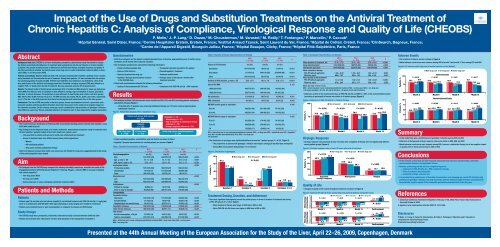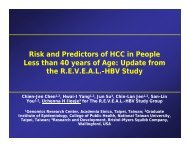Impact of the Drug Use and Substitution Treatments
Impact of the Drug Use and Substitution Treatments
Impact of the Drug Use and Substitution Treatments
Create successful ePaper yourself
Turn your PDF publications into a flip-book with our unique Google optimized e-Paper software.
<strong>Impact</strong> <strong>of</strong> <strong>the</strong> <strong>Use</strong> <strong>of</strong> <strong>Drug</strong>s <strong>and</strong> <strong>Substitution</strong> <strong>Treatments</strong> on <strong>the</strong> Antiviral Treatment <strong>of</strong>Chronic Hepatitis C: Analysis <strong>of</strong> Compliance, Virological Response <strong>and</strong> Quality <strong>of</strong> Life (CHEOBS)P. Melin, 1 J.-P. Lang, 2 D. Ouzan, 3 M. Chousterman, 4 M. Varastet, 5 M. Rotily, 5 T. Fontanges, 6 P. Marcellin, 7 P. Cacoub 81Hôpital Général, Saint Dizier, France; 2 Centre Hospitalier Erstein, Erstein, France; 3 Institut Arnaud Tzanck, Saint Laurent du Var, France; 4 Hôpital de Créteil, Créteil, France; 5 ClinSearch, Bagneux, France;6Centre de l’Appareil Digestif, Bourgoin Jallieu, France; 7 Hôpital Beaujon, Clichy, France; 8 Hôpital Pitié-Salpêtrière, Paris, FranceAbstractBackground <strong>and</strong> aims: CHEOBS is a French multicenter, prospective, observational study that aimed to analyse<strong>the</strong> factors associated with adherence to treatment with peginterferon alfa-2b <strong>and</strong> ribavirin in chronic hepatitisC patients. The present analysis focuses on adherence to antiviral dual <strong>the</strong>rapy, virological response, <strong>and</strong> quality <strong>of</strong>life (QoL) according to whe<strong>the</strong>r <strong>the</strong> patients were active drug users or under substitution treatment (ADU), ex-drugusers (EDU), or non-drug users (NDU).Patients <strong>and</strong> methods: Between 2003 <strong>and</strong> 2006, 184 clinicians evaluated 2001 hepatitis C patients every 3 monthsduring treatment <strong>and</strong> 6 months after <strong>the</strong> end <strong>of</strong> treatment. Among <strong>the</strong>se patients, 141 were excluded from <strong>the</strong> analysis.The studied population included 244 ADU, 578 EDU <strong>and</strong> 1038 NDU. Good adherence was defined by >80% <strong>of</strong> <strong>the</strong>dose <strong>and</strong> duration <strong>of</strong> <strong>the</strong> antiviral dual <strong>the</strong>rapy prescribed. Sustained virological response (SVR) was defined by anegative PCR ≥12 weeks after <strong>the</strong> end <strong>of</strong> treatment. QoL was assessed using <strong>the</strong> SF-36 questionnaire.Results: The patient pr<strong>of</strong>ile in <strong>the</strong> EDU group was between that in <strong>the</strong> ADU <strong>and</strong> NDU groups for mean age, body massindex (BMI), liver fibrosis, level <strong>of</strong> education or debt difficult to manage, high consumption <strong>of</strong> alcohol, psychiatricdisorders, or chronic diseases. The proportion <strong>of</strong> good adherents to dual <strong>the</strong>rapy was similar in all three groups:NDU, 49.4%; EDU, 48.6%; ADU, 52.2% (p=0.7). The SVR rate was also similar: 49.3%, 50.9%, <strong>and</strong> 57.8%, respectively(p=0.1). The QoL in <strong>the</strong> ADU group was less altered on <strong>the</strong> physical <strong>and</strong> mental levels than in <strong>the</strong> o<strong>the</strong>r groups.Conclusions: The rate <strong>of</strong> SVR was similar in <strong>the</strong> three groups. Excess consumption <strong>of</strong> alcohol, a precarious socioeconomicsituation, <strong>and</strong> <strong>the</strong> psychiatric disorders observed in drug users in this study had no negative impact on<strong>the</strong> treatment outcomes. On <strong>the</strong> contrary, young age, recent contamination, high prevalence <strong>of</strong> genotype 3 infection,lower BMI, less severe liver fibrosis, <strong>and</strong> good adherence to treatment seem to have balanced <strong>the</strong> negative parameters.Background• The French Consensus Conference <strong>of</strong> February 2002 recommended treating patients infected with hepatitis C virus(HCV) with stable drug use 1• Key findings from <strong>the</strong> Hepacom Study, a 12-month, multicenter, observational prospective study <strong>of</strong> treatment-naivechronic hepatitis C patients treated in <strong>the</strong> French health care system, were 2 :— Only one-third <strong>of</strong> patients with access to health care initiated antiviral treatment— Access to treatment was more difficult among <strong>the</strong>se patient populations:WomenHIV-coinfected patients<strong>Drug</strong> users receiving substitution <strong>the</strong>rapy• Data from Hepacom revealed that health care access was still limited for drug users, suggesting that fur<strong>the</strong>r study<strong>of</strong> this patient population was neededAim• This analysis from <strong>the</strong> CHEOBS study compared <strong>the</strong> efficacy, tolerability, compliance, <strong>and</strong> effect on quality <strong>of</strong> life<strong>of</strong> pegylated interferon (PEG-IFN) alfa-2b (PegIntron ® ; Schering-Plough) + ribavirin (RBV) in 3 groups <strong>of</strong> patientswith chronic hepatitis C— Non-drug users (NDU)— Ex-drug users (EDU)— Active drug users or users undergoing substitution treatment (ADU)Patients <strong>and</strong> MethodsPatients• Patients aged 18 <strong>and</strong> older who had chronic hepatitis C <strong>and</strong> initiated treatment with PEG-IFN alfa-2b (1.5 µg/kg/wk)alone or in combination with RBV (800-1200 mg/d, depending on body weight) were eligible for enrollment• Patients were treatment naive or were nonresponders or relapsers to previous anti-HCV <strong>the</strong>rapyStudy Design• The CHEOBS study was a prospective, multicenter, observational study conducted between 2003 <strong>and</strong> 2006• Patients were enrolled from 184 centers in France that specialize in <strong>the</strong> management <strong>of</strong> hepatitis CQuestionnaires• Both <strong>the</strong> investigator <strong>and</strong> <strong>the</strong> patient completed questionnaires at baseline, approximately every 3 months duringtreatment, <strong>and</strong> 6 months after treatment cessation• The investigator questionnaire collected <strong>the</strong> following information:— Patient sociodemographic data — Therapeutic education provided to <strong>the</strong> patient— History <strong>of</strong> HCV infection — Planned hepatitis C treatment— History <strong>of</strong> psychoactive drug use — Treatment modifications— Hepatitis C <strong>the</strong>rapy received before inclusion — Virologic status <strong>of</strong> <strong>the</strong> patient 6 months afterin <strong>the</strong> CHEOBS studytreatment cessation• Patient self-questionnaires collected <strong>the</strong> following information: — Quality-<strong>of</strong>-life assessment (SF-36 form) — Compliance with PEG-IFN alfa-2b + RBV treatmentResults• This analysis includes 1860 patients who were classified as NDU, EDU, <strong>and</strong> ADU (including patients undergoingsubstitution <strong>the</strong>rapy) (Figure 1)— Of <strong>the</strong> 244 ADU, 72 patients were receiving methadone <strong>the</strong>rapy <strong>and</strong> 137 were receiving buprenorphinesubstitution treatmentFigure 1. Patient flow diagram. HCV = hepatitis C virus.Non-drug usersn = 1038Patients with chronic HCV infectionN = 2001Analyzedn = 1860Ex-drug usersn = 578• Patient sociodemographics, comorbidities, <strong>and</strong> risk factors are shown in Table 1• Hepatitis C disease characteristics for enrolled patients are shown in Table 2Table 1. Baseline Characteristics <strong>of</strong> PatientsExcluded: n = 141- Mono<strong>the</strong>rapy (n = 37)- Date <strong>of</strong> cessation <strong>of</strong> combination <strong>the</strong>rapyunknown (n = 79)- Virologic response unknown (n = 25)Active drug users or substituted patientsn = 244NDUEDUADUPn = 1038n = 578n = 244Sociodemographics n/n (%) n/n (%) n/n (%)Men 512/1035 (49) 428/578 (74) 198/243 (82)
<strong>Impact</strong> <strong>of</strong> <strong>the</strong>PresentedChronic Hepatitis1Hôpital Général, SaAbstractBackground <strong>and</strong> aims: CHEOBS is a French multicenter, prospective, observational study that aimed to analyse<strong>the</strong> factors associated with adherence to treatment with peginterferon alfa-2b <strong>and</strong> ribavirin in chronic hepatitisC patients. The present analysis focuses on adherence to antiviral dual <strong>the</strong>rapy, virological response, <strong>and</strong> quality <strong>of</strong>life (QoL) according to whe<strong>the</strong>r <strong>the</strong> patients were active drug users or under substitution treatment (ADU), ex-drugusers (EDU), or non-drug users (NDU).Patients <strong>and</strong> methods: Between 2003 <strong>and</strong> 2006, 184 clinicians evaluated 2001 hepatitis C patients every 3 monthsduring treatment <strong>and</strong> 6 months after <strong>the</strong> end <strong>of</strong> treatment. Among <strong>the</strong>se patients, 141 were excluded from <strong>the</strong> analysis.The studied population included 244 ADU, 578 EDU <strong>and</strong> 1038 NDU. Good adherence was defined by >80% <strong>of</strong> <strong>the</strong>dose <strong>and</strong> duration <strong>of</strong> <strong>the</strong> antiviral dual <strong>the</strong>rapy prescribed. Sustained virological response (SVR) was defined by anegative PCR ≥12 weeks after <strong>the</strong> end <strong>of</strong> treatment. QoL was assessed using <strong>the</strong> SF-36 questionnaire.Results: The patient pr<strong>of</strong>ile in <strong>the</strong> EDU group was between that in <strong>the</strong> ADU <strong>and</strong> NDU groups for mean age, body massindex (BMI), liver fibrosis, level <strong>of</strong> education or debt difficult to manage, high consumption <strong>of</strong> alcohol, psychiatricdisorders, or chronic diseases. The proportion <strong>of</strong> good adherents to dual <strong>the</strong>rapy was similar in all three groups:NDU, 49.4%; EDU, 48.6%; ADU, 52.2% (p=0.7). The SVR rate was also similar: 49.3%, 50.9%, <strong>and</strong> 57.8%, respectively(p=0.1). The QoL in <strong>the</strong> ADU group was less altered on <strong>the</strong> physical <strong>and</strong> mental levels than in <strong>the</strong> o<strong>the</strong>r groups.Conclusions: The rate <strong>of</strong> SVR was similar in <strong>the</strong> three groups. Excess consumption <strong>of</strong> alcohol, a precarious socioeconomicsituation, <strong>and</strong> <strong>the</strong> psychiatric disorders observed in drug users in this study had no negative impact on<strong>the</strong> treatment outcomes. On <strong>the</strong> contrary, young age, recent contamination, high prevalence <strong>of</strong> genotype 3 infection,lower BMI, less severe liver fibrosis, <strong>and</strong> good adherence to treatment seem to have balanced <strong>the</strong> negative parameters.Background• The French Consensus Conference <strong>of</strong> February 2002 recommended treating patients infected with hepatitis C virus(HCV) with stable drug use 1• Key findings from <strong>the</strong> Hepacom Study, a 12-month, multicenter, observational prospective study <strong>of</strong> treatment-naivechronic hepatitis C patients treated in <strong>the</strong> French health care system, were 2 :— Only one-third <strong>of</strong> patients with access to health care initiated antiviral treatment— Access to treatment was more difficult among <strong>the</strong>se patient populations:WomenHIV-coinfected patients<strong>Drug</strong> users receiving substitution <strong>the</strong>rapy• Data from Hepacom revealed that health care access was still limited for drug users, suggesting that fur<strong>the</strong>r study<strong>of</strong> this patient population was neededAim• This analysis from <strong>the</strong> CHEOBS study compared <strong>the</strong> efficacy, tolerability, compliance, <strong>and</strong> effect on quality <strong>of</strong> life<strong>of</strong> pegylated interferon (PEG-IFN) alfa-2b (PegIntron ® ; Schering-Plough) + ribavirin (RBV) in 3 groups <strong>of</strong> patientswith chronic hepatitis C— Non-drug users (NDU)— Ex-drug users (EDU)— Active drug users or users undergoing substitution treatment (ADU)Patients <strong>and</strong> MethodsPatients• Patients aged 18 <strong>and</strong> older who had chronic hepatitis C <strong>and</strong> initiated treatment with PEG-IFN alfa-2b (1.5 µg/kg/wk)alone or in combination with RBV (800-1200 mg/d, depending on body weight) were eligible for enrollment• Patients were treatment naive or were nonresponders or relapsers to previous anti-HCV <strong>the</strong>rapyStudy Design• The CHEOBS study was a prospective, multicenter, observational study conducted between 2003 <strong>and</strong> 2006• Patients were enrolled from 184 centers in France that specialize in <strong>the</strong> management <strong>of</strong> hepatitis C
e <strong>Use</strong> <strong>of</strong> <strong>Drug</strong>s <strong>and</strong> SC: Analysis <strong>of</strong> ComplP. Melin, 1 J.-P. Lang, 2 D. OuzanSaint Dizier, France; 2 Centre Hospitalier Erstein, Erstein, F6Centre de l’Appareil Digestif, BourgoiQuestionnaires• Both <strong>the</strong> investigator <strong>and</strong> <strong>the</strong> patient completed questionnaires at baseline, approximately every 3 months duringtreatment, <strong>and</strong> 6 months after treatment cessation• The investigator questionnaire collected <strong>the</strong> following information:— Patient sociodemographic data — Therapeutic education provided to <strong>the</strong> patient— History <strong>of</strong> HCV infection — Planned hepatitis C treatment— History <strong>of</strong> psychoactive drug use — Treatment modifications— Hepatitis C <strong>the</strong>rapy received before inclusion — Virologic status <strong>of</strong> <strong>the</strong> patient 6 months afterin <strong>the</strong> CHEOBS studytreatment cessation• Patient self-questionnaires collected <strong>the</strong> following information: — Quality-<strong>of</strong>-life assessment (SF-36 form) — Compliance with PEG-IFN alfa-2b + RBV treatmentResults.• This analysis includes 1860 patients who were classified as NDU, EDU, <strong>and</strong> ADU (including patients undergoingsubstitution <strong>the</strong>rapy) (Figure 1)— Of <strong>the</strong> 244 ADU, 72 patients were receiving methadone <strong>the</strong>rapy <strong>and</strong> 137 were receiving buprenorphinesubstitution treatmentFigure 1. Patient flow diagram. HCV = hepatitis C virus.seNon-drug usersn = 1038Patients with chronic HCV infectionN = 2001Analyzedn = 1860Ex-drug usersn = 578Excluded: n = 141- Mono<strong>the</strong>rapy (n = 37)- Date <strong>of</strong> cessation <strong>of</strong> combination <strong>the</strong>rapyunknown (n = 79)- Virologic response unknown (n = 25)Active drug users or substituted patientsn = 244• Patient sociodemographics, comorbidities, <strong>and</strong> risk factors are shown in Table 1• Hepatitis C disease characteristics for enrolled patients are shown in Table 2)Table 1. Baseline Characteristics <strong>of</strong> PatientsNDUEDUADUPn = 1038n = 578n = 244Sociodemographics n/n (%) n/n (%) n/n (%)Men 512/1035 (49) 428/578 (74) 198/243 (82)
ubstitution Treatmenliance, Virological Re, 3 M. Chousterman, 4 M. Varastet, 5 M. Rotily, 5 T. FontangeFrance; 3 Institut Arnaud Tzanck, Saint Laurent du Var, Frain Jallieu, France; 7 Hôpital Beaujon, Clichy, France; 8 HôpTable 2. Hepatitis C Disease Characteristics <strong>and</strong> EtiologyNDUn = 1038EDUn = 578ADUn = 244PSource <strong>of</strong> HCV infection n/n (%) n/n (%) n/n (%)Transfusion 474/1019 (47) 19/578 (3) 3/244 (1)
ts on <strong>the</strong> Antiviral Tresponse <strong>and</strong> Quality os, 6 P. Marcellin, 7 P. Cacoub 8ance; 4 Hôpital de Créteil, Créteil, France; 5 ClinSearch, Baital Pitié-Salpêtrière, Paris, FranceTable 3. Investigator-Reported Dose <strong>and</strong> DurationNDUEDUADUn = 1038n = 578n = 244PMean duration <strong>of</strong> treatment, wk 37.4 ± 17.6 35.0 ± 16.2 33.0 ± 16.6
eatment <strong>of</strong>f Life (CHEOBS)agneux, France;Adverse Events• The incidence <strong>of</strong> adverse events is shown in Figure 6• Mental adverse events were more common among ADU at month 3 <strong>and</strong> month 12 than among EDU <strong>and</strong> NDUFigure 6. All adverse events (top) <strong>and</strong> all mental adverse events (bottom).Non-drug user Ex-drug user Active drug userPatients, %10075P = 0.016 P = 0.091 P = 0.021 P = 0.01781.979.373.9Adverse Events79.078.981.173.9 75.674.273.369.769.9Patients, %5010075502535.9Month 3 Month 6 Month 9 Month 12Mental Adverse EventsP = 0.002 P = 0.289 P = 0.474 P = 0.00842.8 46.842.9 45.5 48.9 40.1 42.9 46.245.738.656.20Month 3 Month 6 Month 9 Month 12Summary• In this study, <strong>the</strong>re was a predominance <strong>of</strong> genotype 3 infection among EDU <strong>and</strong> ADU• Adherence to <strong>the</strong>rapy <strong>and</strong> virologic response rates were similar in ADU, EDU, <strong>and</strong> NDU• Mental adverse events were more frequent among ADU; however, combination <strong>the</strong>rapy had a less negative impacton quality <strong>of</strong> life in <strong>the</strong>se patients than in EDU or NDUConclusions• In this analysis, active drug use was frequently associated with excessive alcohol intake, vulnerablesocioeconomic situation, <strong>and</strong> psychiatric illness• However, active drug use did not have a negative impact on— Adherence to PEG-IFN alfa-2b + RBV combination <strong>the</strong>rapy— Rate <strong>of</strong> premature discontinuation— Sustained virologic response rate• It is possible that a predominance <strong>of</strong> favorable characteristics, such as young age, recent HCV infection, highprevalence <strong>of</strong> genotype 3 infection, low body mass index, <strong>and</strong> less advanced stage <strong>of</strong> fibrosis counterbalanced<strong>the</strong> potentially negative impact <strong>of</strong> <strong>the</strong> unfavorable parameters associated with active drug useReferences1. Consensus Conference: Treatment <strong>of</strong> Hepatitis C; February 27-28, 2002; Paris, France. http://www.anaes.fr.Accessed October 6, 2008.2. Agostini H et al. Gastroenterol Clin Biol. 2007;31:1074-1080.DisclosuresP. Melin, J.-P. Lang, D. Ouzan, M. Chousterman, M. Rotily, T. Fontanges, P. Marcellin, <strong>and</strong> P. Cacoub areconsultants for Schering-Plough France.M. Varastet has nothing to disclose.enmark





